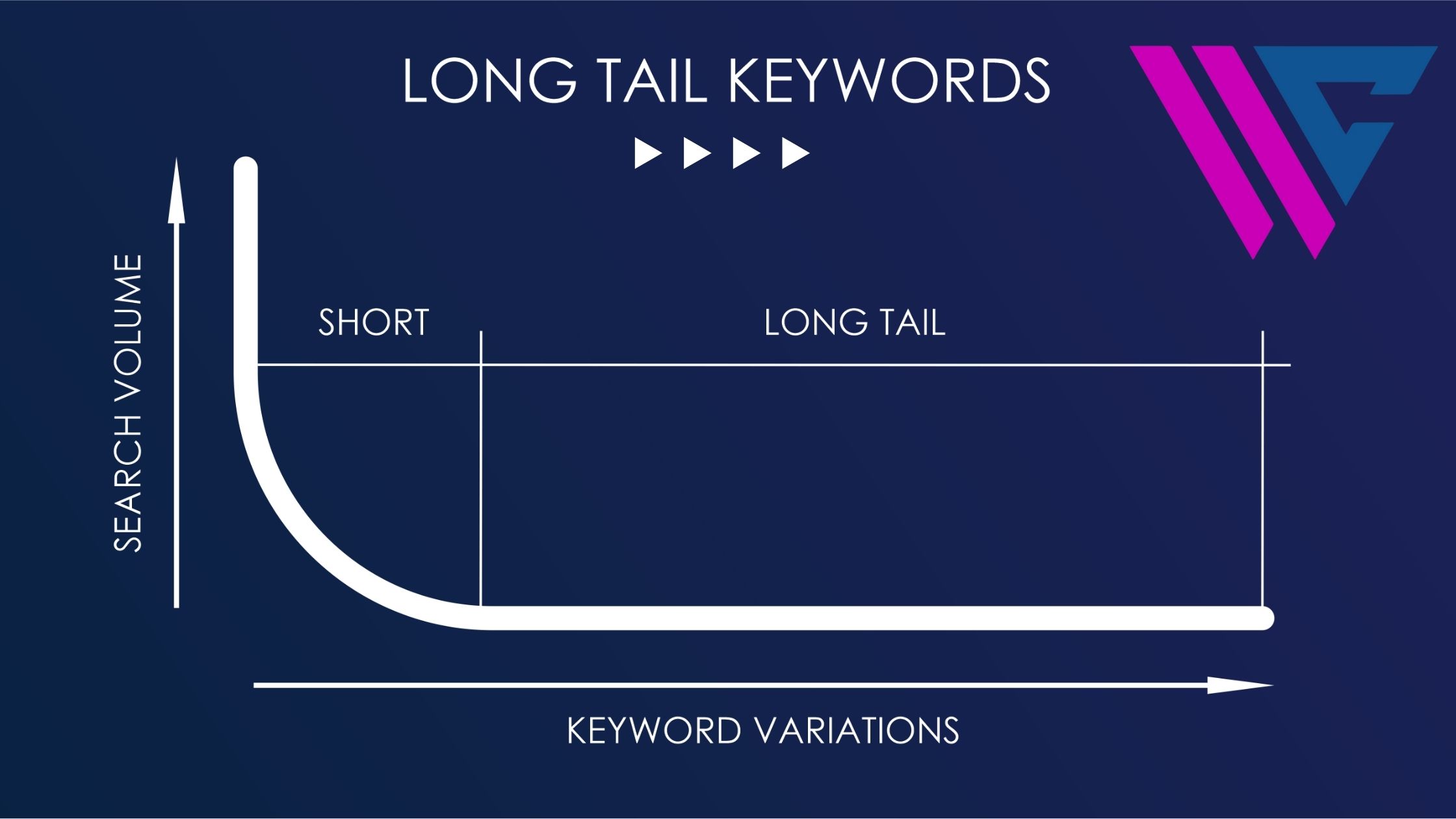In the vast landscape of digital marketing, especially in the category of SEO, the term Long Tail Keywords has emerged as a beacon for businesses striving to enhance their online visibility.
These unique and specific phrases, comprising three or more words, are crucial in navigating the intricacies of effective online searches. Unlike their broader counterparts, long tail keywords offer a precision that resonates with users’ needs and intents.
These aren’t just words; they’re the secret sauce for boosting your online presence. So, let’s roll up our sleeves and explore these magical phrases that can turn your SEO game from good to extraordinary.
What is Long Tail Keywords In SEO
Long tail keywords are specific, niche phrases containing three or more words, allowing for more precise targeting in online searches. They cater to specific user intents, often have lower competition, and get less search traffic, but will have a higher conversion value because of their specific nature enhancing the effectiveness of SEO strategies.
Characteristics of Long Tail Keywords
So, what sets these keywords apart? Or what special characteristics do they possess? First, they’re specific, like a laser beam, addressing user needs or queries. Secondly, they love to hang out in specific niches, making them the go-to for businesses targeting a specialized audience.
These specific phrases boast characteristics that set them apart:
Specificity: Long tail keywords are highly specific, addressing particular user needs or queries.
Niche Appeal: They often belong to specific niches, making them valuable for businesses targeting a specialized audience.
Lower Competition: Due to their specificity, long tail keywords usually face lower competition, providing a golden opportunity for businesses to stand out.
Advantages of Using Long Tail Keywords in SEO
It Targets Traffic and Conversion
Long tail keywords act like a magnet, pulling in a specific audience directly interested in what you offer. While the numbers may not be massive, the quality of these visitors is crucial. This focused approach significantly boosts the chances of turning visitors into actual customers, making every click more valuable for your business.
It has Low Competition
In the vast landscape of SEO, where generic keywords compete in a crowded marketplace, these keywords provide a less competitive space. This lower competition ensures your content stands out and gets noticed by those actively searching for your products or services. This helps users to specify their queries or needs in a particular area.
It Enhances Relevance and User Intent
Long tail keywords function as precise guides, aligning seamlessly with what users are actively searching for. This specificity creates a personalized and relevant online experience for the searcher, fostering a genuine connection with your audience and building trust and loyalty.
Cost-effective advertising and PPC Campaigns
For businesses on a budget, targeting these big-tail keywords in ads or PPC campaigns is a cost-effective strategy. It’s like placing targeted ads in a niche platform where your ideal customers are more likely to see them. The cost-effectiveness, combined with targeted reach, makes it a strategic choice for maximizing your advertising budget.
Examples of Long Tail Keywords
Industry-Specific Examples:
To understand the practical application of these big tail keywords, let’s explore industry-specific examples that showcase the transition from short tell keyword to highly specific:
- Short Tail Keyword: Running shoes
Here we can see that the keyword is generic and only asks about running shoes and he is not being specific about it. With a 146k search volume, it has super hard keyword difficulty making it highly competitive.

- Long Tail Keyword: Best lightweight running shoes
But here in the long tail keyword, the phrase is more specified as it is asking about running shoes but with the nature of the best lightweight running shoes. With only 600 search volume it has such an easy keyword difficulty of 1 making it less competitive.

User Intent Examples:
User intent plays a pivotal role in crafting effective long tail keywords. Here are examples that reflect the alignment of keywords with specific user needs:
- Short Tail Keyword: Healthy Recipes
Here this keyword is only talking about healthy recipes which have a 43k search volume we know that there are thousands of such recipes present on the internet and it makes it tough for the website owner to rank with such keyword difficulty as it’s showing 77 with superhard remark.

- Long Tail Keyword: low-carb dinner recipes for weight loss
But the case is different with the short tail keyword as it is more specific with its demand that it wants those recipes that are low in carbs and are useful for weight loss. It has a low volume and also the keyword difficulty is 29 making it medium difficult and it helps users to rank easily.

So from both types of examples what we have come to know is that the generic keywords have high search volume with high KD which is keyword difficulty. Whereas the long tail keywords, it has low search volume and low KD. Because of this specialty, it has the power to boost and rank the performance of your website easily within specific niches with lower competition.
How to Find Long Tail Keywords
By Using Keyword Research Tools
One of the most efficient ways to find long tail keywords is through dedicated keyword research tools. Platforms like SEMrush, Ahrefs, and Google Keyword Planner provide valuable insights into search volumes, competition, and related keywords. Start by entering a broad term related to your niche, and these tools will generate a list of potential long keywords.
These tools often display variations of your initial query, along with metrics like search volume and keyword difficulty. Look for keywords that strike a balance between relevance to your content and a reasonable level of competition. Long tail keywords discovered through these tools can form the foundation of your content strategy, ensuring that you address specific user needs.
By Analyzing User Queries
Understanding your audience’s intent is crucial for finding long keywords that resonate with their needs. Analyzing user queries from sources like forums, social media, and customer support interactions can provide valuable insights into the language and specific phrases your audience uses.
Pay attention to the questions and problems users express. Tools like AnswerThePublic can aggregate common questions about a specific topic, helping you identify potential long keywords. Crafting content that directly addresses these queries improves your SEO and establishes your brand as a valuable resource in your industry.
By Doing Competitor Analysis and Niche Exploration
Your competitors can be a goldmine for discovering long tail keywords. Analyze the content of your competitors, especially those who are ranking well in search engine results for your target keywords. Identify the long keywords they are targeting and explore similar topics that might be relevant to your audience.
Additionally, consider exploring niche forums and communities related to your industry. These platforms often host discussions around specific topics, revealing unique phrases and keywords that might not be immediately apparent through traditional research methods.
By Utilizing Google Search Suggestions and Autocomplete
Google itself can be a powerful tool for finding long keywords. When you start typing a query into the search bar, Google’s autocomplete feature suggests popular search phrases based on user behavior. These suggestions can provide valuable insights into the specific terms users are actively searching for.
Take note of these suggestions and use them as a starting point for crafting content. Since these suggestions are driven by real-time user behavior, incorporating them into your content can help you align with current search trends and capture relevant traffic.
How to Use Long Tail Keywords Effectively
By Optimizing the Content
Once you’ve identified relevant long keywords, it’s crucial to seamlessly integrate them into your content. Avoid forced or unnatural placement; instead, organically incorporate these keywords into your headlines, subheadings, and throughout the body of your content.
This helps search engines recognize the relevance of your content to specific user queries. This optimization not only enhances your content’s search engine ranking but also improves the overall user experience by providing valuable information in response to specific queries.
By Creating Quality Content
While optimizing for keywords is essential, the quality of your content remains paramount. Long tail keywords should serve as a guide rather than a rigid framework. Craft content that genuinely addresses the user’s needs, offers valuable insights and provides solutions to their queries.
Google’s algorithms prioritize content that demonstrates expertise, authority, and trustworthiness (E-A-T). Therefore, focus on creating comprehensive and informative content that goes beyond merely incorporating keywords. Quality content not only attracts visitors but also encourages engagement and establishes your website as a reliable resource within your niche.
By Integrating Natural Meta Tags and Headers
Meta tags and headers play a crucial role in signalling the relevance of your content to search engines. Ensure that your meta title and description incorporate long tail keywords naturally and compellingly. This not only improves your click-through rate but also reinforces the topical relevance of your content.
Similarly, use long tail keywords in headers (H1, H2, etc.) to structure your content. This practice not only enhances readability but also provides search engines with additional cues about the key topics covered in your content. And you have to be mindful of technical SEO also and for that you can read our blog post about Canonical Tag and learn how to implement it for better performance.
By Doing Regular Monitoring and Adjustments
The digital landscape is dynamic, and search trends can change over time. To ensure the ongoing effectiveness of your long tail keywords, establish a routine for monitoring and adjusting your content strategy. Regularly check the performance of your pages using tools like Google Analytics and Search Console.
Pay attention to user behavior, search rankings, and changes in keyword trends. If certain long keywords are consistently driving traffic and engagement, consider creating more content around those topics. Conversely, if some keywords are underperforming, revisit your content and make adjustments to improve its relevance and appeal.
Revolutionize Your Online Visibility with Our Digital Marketing Expertise
Are you looking to elevate your online presence and reach your target audience effectively? Our team of digital marketing experts is here to help you unlock the full potential of your online strategy. With a tailored approach and proven techniques, we can revolutionize your online visibility and drive meaningful results for your business. Let’s embark on this journey together and take your brand to new heights in the digital landscape.
FAQs About Long Tail Keywords
1. How do you identify long-tail keywords?
Identifying these keywords involves understanding your target audience, conducting thorough keyword research, and analyzing user queries. Utilize keyword research tools, explore niche forums, and pay attention to Google’s autocomplete suggestions to uncover relevant long keywords tailored to your content.
2. How Do Long Tail Keywords Benefit SEO?
Long tail keywords offer several benefits for SEO efforts. They typically have lower competition compared to broad keywords, making it easier for your content to rank higher in search engine results. Additionally, these keywords attract highly targeted traffic, resulting in higher conversion rates and improved user engagement.
3. What is the long tail keyword limit?
There is no specific limit to the number of long keywords you can target. However, it’s essential to prioritize quality over quantity. Focus on identifying these keywords that are highly relevant to your content and align with your target audience’s search intent.
4. How Can I Find Long Tail Keywords?
Finding long tail keywords involves using a combination of keyword research tools, analyzing user queries, and exploring competitor strategies. Leverage tools like SEMrush, Ahrefs, and Google Keyword Planner to identify relevant long keywords that resonate with your audience’s needs and preferences.
5. What’s the Best Way to Use Long Tail Keywords Effectively?
To use long tail keywords effectively, optimize your content by seamlessly integrating them into your headlines, subheadings, and body copy. Create high-quality, informative content that addresses specific user queries and provides valuable insights. Regularly monitor keyword performance and make adjustments to your strategy based on changing trends and user behavior.
Ready to elevate your online presence? Contact Webcazdor Digital Solutions today and let our digital marketing experts guide you through the transformative power of long tail keywords. Revolutionize your visibility and stay ahead in the digital landscape.






